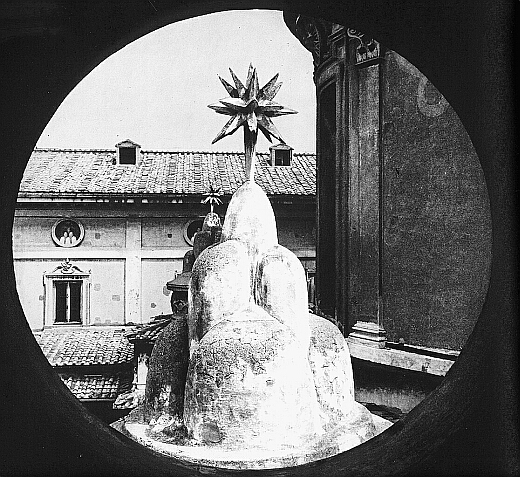
History of Architecture - Integrative course (20 hours) of Early modern Art B
(email: This email address is being protected from spambots. You need JavaScript enabled to view it.)
A.Y. 2021-2022
Lectures on
Roman Baroque Architecture
Syllabus
The course will examine the historical period of architecture from the second half of the 16th century in Rome to the Council of Trent and the ecclesiastical reform that led to changes in the architectural systems of the churches of religious orders, and the early Baroque period. The architecture that transformed the city from the pontificate of Sixtus V to that of Paul V and their architects. The course will deal with the Baroque revolution in architecture with a focus on new themes: meanings and themes of the Baroque, general characteristics, history and fortune of the term, the urban space of Roman Baroque architecture, infinity, and illusionism, which will be illustrated through a few visits to architectural emergencies in the city of Rome. The visits will focus on some architecture of the early Baroque period and on some architectural works by Francesco Borromini, Pietro da Cortona and Gian Lorenzo Bernini.
Lecture n.1: 7th March (ore 10.00-14.00).
1) Introduction to the course. Main objectives and explanation of the exercise required
Early Baroque Period:
1) Villa Mondragone
2) From Sixtus V to Paul V (1585-1621). The council of Trent and the Arts – The Church and the Reformers. The architecture at the time of Sixtus V. The architecture at the time of Paolo V and Cardinal Scipione Borghese.
Lecture n.2: 25th March (ore 9.00-12.00). Visit. Appointment via degli Astalli 16.
Early Baroque Period.
1) La chiesa del Gesù, Sant’Ignazio, Sant’Andrea della Valle, San Carlo ai Catinari
Lecture n.3: 8th April (10.00-14.00)
Baroque Architecture
1) Meanings and themes of the Baroque. General features, history and fortune of the term, themes of the Baroque architecture. Urban space of Roman Baroque architecture, infinity, illusionism.
Baroque Architecture
2) Francesco Borromini. San Carlo alle Quattro Fontane, Sant’ Ivo alla Sapienza, San Giovanni in Laterano, Santa Agnese a piazza Navona, Sant’Andrea delle Fratte (Tower and Dome), Collegio di Propaganda Fide, Oratorio di San Filippo Neri.
Lecture n. 4: 29th April (10.00-14.00) Visit. Appointment piazza del Popolo
Baroque Architecture. Walking on an urban route of Roman Baroque
1) Pietro da Cortona: Chiesa di santa Maria della Pace, Santa Maria in Via Lata, San Carlo al Corso.
2) Francesco Borromini: Sant’ Ivo alla Sapienza, Santa Agnese a piazza Navona
3) Gian Lorenzo Bernini. Santa Maria del Popolo, Palazzo di Montecitorio.
Lecture n.5: 4th May (10.00-13.00) Visit. Appointment at Villa Mondragone
1) Villa Mondragone
Lecture n. 6: 18th May (10.00-12.00) Visit. Appointment via del Quirinale 23
Baroque Architecture
1) San Carlino alle Quattro Fontane
2) Sant’Andrea delle Fratte
A visit to the Quirinale Palace is planned for April /May.
Bibliography:
- R. Wittkower, Art and Architecture in Italy 1600 to 1750, Harmondsworth, Penguin Books, 1° ed. 1958 (ed. ital. Torino, Einaudi, 1958, many times reprinted).
- J. Connors, Alliance and enmity in Roman Baroque urbanism, in Römisches Jahrbuch der Bibliotheca Hertziana, XXV, 1989, pp. 207-294 (1° ed. ital. Roma-Bari, Laterza, 2005)
- J. Connors, Borromini and the Roman oratory: style and society, Cambridge (Mass.), MIT Press 1980 (1° ed. ital. Torino, Einaudi, 1989).
- C. Norberg-Schulz, Baroque Architecture, New York, Abrams, 1971.
- C. Norberg-Schulz, Late Baroque and Rococo Architecture, New York, Abrams, 1973.
- Handouts by the teacher and, on Villa Mondragone: M. Richiello, From construction phases (Altemps - Borghese) to restorations (XIX - XX century), in: Villa Mondragone "second Rome", Formica M. ed., Rome, Palombi 2015.
HOW TO GET TO VILLA MONDRAGONE
Villa Mondragone images
Villa Mondragone ITA
Villa Mondragone ENG
